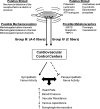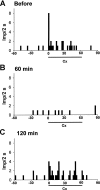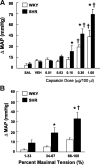Cardiovascular regulation by skeletal muscle reflexes in health and disease
- PMID: 21841019
- PMCID: PMC3197431
- DOI: 10.1152/ajpheart.00208.2011
Cardiovascular regulation by skeletal muscle reflexes in health and disease
Abstract
Heart rate and blood pressure are elevated at the onset and throughout the duration of dynamic or static exercise. These neurally mediated cardiovascular adjustments to physical activity are regulated, in part, by a peripheral reflex originating in contracting skeletal muscle termed the exercise pressor reflex. Mechanically sensitive and metabolically sensitive receptors activating the exercise pressor reflex are located on the unencapsulated nerve terminals of group III and group IV afferent sensory neurons, respectively. Mechanoreceptors are stimulated by the physical distortion of their receptive fields during muscle contraction and can be sensitized by the production of metabolites generated by working skeletal myocytes. The chemical by-products of muscle contraction also stimulate metaboreceptors. Once activated, group III and IV sensory impulses are transmitted to cardiovascular control centers within the brain stem where they are integrated and processed. Activation of the reflex results in an increase in efferent sympathetic nerve activity and a withdrawal of parasympathetic nerve activity. These actions result in the precise alterations in cardiovascular hemodynamics requisite to meet the metabolic demands of working skeletal muscle. Coordinated activity by this reflex is altered after the development of cardiovascular disease, generating exaggerated increases in sympathetic nerve activity, blood pressure, heart rate, and vascular resistance. The basic components and operational characteristics of the reflex, the techniques used in human and animals to study the reflex, and the emerging evidence describing the dysfunction of the reflex with the advent of cardiovascular disease are highlighted in this review.
Figures






References
-
- Abrahams VC. Group III and IV receptors of skeletal muscle. Can J Physiol Pharmacol 64: 509–514, 1986 - PubMed
-
- Adreani CM, Hill JM, Kaufman MP. Responses of group III and IV muscle afferents to dynamic exercise. J Appl Physiol 82: 1811–1817, 1997 - PubMed
-
- Adreani CM, Kaufman MP. Effect of arterial occlusion on responses of group III and IV afferents to dynamic exercise. J Appl Physiol 84: 1827–1833, 1998 - PubMed
Publication types
MeSH terms
Grants and funding
LinkOut - more resources
Full Text Sources
Medical

